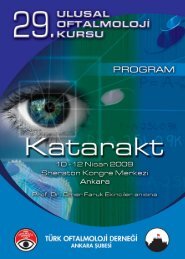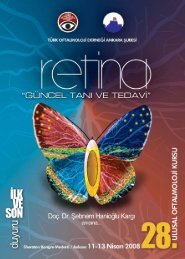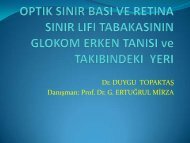Book
ABSTRACT BOOK.qxd
ABSTRACT BOOK.qxd
- No tags were found...
Create successful ePaper yourself
Turn your PDF publications into a flip-book with our unique Google optimized e-Paper software.
Abstract <strong>Book</strong><br />
P1-1<br />
AUTOINFLAMMATORY CONDITIONS IN CHILDREN:<br />
WHAT SHOULD WE KNOW?<br />
Anne-Marie Prieur (Paris, France)<br />
M a i n ly four groups of diseases are at risk of eye infl a m m ation with<br />
va rious degrees of seve ri t y. 1) Ju venile Idiopathic A rt h ritis (JIA). Th e<br />
most common is ch ronic anterior uveitis in the oligo a rticular fo rm<br />
o c c u rring mostly in ve ry young gi rls and associated with serum antinu<br />
clear antibody. Acute anterior uveitis can be observed is young boy s<br />
with enthesitis associated art h ro p at hy. 2) Some autoimmune conditions<br />
are ch a ra c t e ri zed by eye infl a m m ation. Wegener gra nu l o m at o s i s<br />
ch a ra c t e ri zed by ANCA affects small and medium sized vessels with<br />
s i nu s i t i s , upper re s p i rat o ry and pulmonary tra c t , k i d n ey… Eye manife<br />
s t ations are from mild conjunctivitis to seve re infl a m m ation (ke rat i-<br />
t i s , retinal vasculitis). Cogan syndrome consists of a ve s t i bu l o a u d i t o-<br />
ry syndrome with sudden hearing loss and bilat e ral interstitial ke rat i-<br />
tis. Sjögren syndro m e, a s s o c i ated to anti Ro anti La antibodies, i s<br />
ch a ra c t e ri zed by dry eye with saliva ry glands swelling and dry mouth,<br />
sometimes kidney invo l vement 3) Genetic disord e rs. The diseases<br />
a s s o c i ated to mu t ations of the CIAS1, p a rt i c u l a rly CINCA, MWS are<br />
a s s o c i ated with optic disk ch a n ge s , ( o e d e m a , at ro p hy) ch ronic anterior<br />
uveitis and often visual loss. Meva l o n ate kinase defi c i e n cy due to<br />
mu t ation in the MVK gene , also called hyperIgD syndrome is assoc<br />
i ated to cat a racts in its most seve re type affecting the infant. Eye<br />
i nvo l vement in Blau syndro m e, due to a mu t ation of the CARD15<br />
gene (also called familial sarcoidosis) is part of the triad ch a ra c t e ri z-<br />
ing the disease with skin rash and art h ritis. Eye invo l vement in Behçet<br />
disease can affect anterior and/or posterior seg m e n t , or manifests as<br />
i ri d o cy cl i t i s , hypopion or retinal va s c u l i t i s , optic disk hy p e remia and<br />
macular oedema. 4) Other diseases such as tubu l o i n t e rstitial nep h ri t i s<br />
and uveitis (TINU) or Vogt Koya n agi Harada syndrome are also assoc<br />
i ated with eye manife s t at i o n s .<br />
P1-2<br />
EPIDEMIOLOGY OF CHILDHOOD UVEITIS: RESULTS<br />
OF AN INTERNATIONAL RETROSPECTIVE MULTICEN-<br />
TER ANALYSIS OF UVEITIS PATIENTS < 19 YEARS<br />
Friederike Mackensen 1 , Sandra Prazeres 2 , Matthias D. Becker 1 ,<br />
Marie-Sophie Enzmann 1 , Celine Terrada2, Bahram Bodaghi 2 ,<br />
A n gela Wat k i n s 3 , G e o rge Reed 4 , Julie Fri e d l i n 5 , D i m i t ry<br />
Pyatesky 5 , H. Nida Sen 4 , Debra Goldstein 5 , Justine R. Smith 3 ,<br />
Janine A. Smith 4<br />
1 Interd i s c i p l i n a ry Uveitis Center, U n ive rsity of Heidelberg,<br />
Germany,<br />
2 Hopital Pitie-Salpetriere, Paris, France,<br />
3 Casey Eye Institute, OHSU, Portland, OR, USA,<br />
4 National Eye Institute, Bethesda, MD, USA,<br />
5University of Illinois, Chicago, IL, USA<br />
P u rp o s e : To describe etiologies, disease activity, and prognosis of<br />
pediatric uveitis.<br />
M e t h o d s : Databases review from 5 uveitis centers (3 US and 2 EU)<br />
with standardized definitions and time points.<br />
R e s u l t s : 853 (527 US, 326 EU) patients with follow-up of 1-10 yrs<br />
were identified. Median age at presentation was 11.2 (US) and 11.0<br />
years (EU), median age at first diagnosis 9.1 (US) and 9 years<br />
(EU). Both groups showed a similar gender distribution (F:M<br />
1.2:1). Centers differed significantly in percentage of Caucasian<br />
patients (EU 88%, US 51-78%).<br />
The most frequent diagnosis in the US was idiopathic uveitis<br />
(28.8%) followed by juvenile idiopathic arthritis (JIA) -related<br />
uveitis (20.9%); in contrast JIA was the most frequent diagnosis in<br />
EU centers (30.8%). In all centers JIA was more frequent among<br />
the children with longer follow-up.<br />
U veitis was active as judged by SUN cri t e ria in 75/79% of ch i l d re n<br />
at the fi rst visit and in 55/40% at the 5 year visit (US/EU). Lega l<br />
blindness (VA < 20/200 in the better eye) was diagnosed in 3/4% at<br />
the fi rst visit and 9/10% at the 5 year and 8/12.5% at the 10 year visit.<br />
Th e re was a negative correlation between VA > 20/50 and complications<br />
at first visit, especially CME and hypotony (p = 0.006 and<br />
0.026) in the US group and epiretinal membrane (p = 0.0425), band<br />
keratopathy, CME and cataract (p = 0.05) in the EU cohort.<br />
At first visit a mean number of 1.4/1.7 (US/EU) complications<br />
were present per child: the most frequent complications were<br />
cataract (28/22%), CME (16.6/11.6 %) and glaucoma (6.4/0.6 %).<br />
In the group of children followed for at least 5 years, 56/46% had<br />
cataract, 30.4/15.38% had CME, and 18.8/25% had glaucoma at<br />
some time during this period.<br />
95/91% received systemic immunosuppressive therapy at any time,<br />
which involved combination therapy of prednisone (or equivalent)<br />
and systemic immunosuppressive drugs (including biologics) in<br />
37/37%. Use of systemic immu n o s u p p re s s ive drugs such as<br />
methotrexate alone or in combination was more frequent in the EU<br />
(52%) than in the US (27 %). The use of biologics was also slightly<br />
more frequent in the EU (10%) than in the US (6%).<br />
More children in EU (29%) than in the US (17%) had surgery during<br />
the observed period. Cataract extraction was the most frequent<br />
type of surgery.<br />
C o n cl u s i o n : Children with uveitis followed by specialized centers<br />
over a long period of time have active and severe disease which<br />
re q u i res intensive tre at m e n t , f re q u e n t ly involving systemic<br />
immunosuppressive drugs including biologics. Still only 10 -12.5%<br />
of them showed legal blindness at the 5-10 year time point, a number<br />
smaller than observed historically, that will hopefully further<br />
decline with the increasing availability of a range of systemic<br />
immunosuppressive drugs.<br />
P1-3<br />
CLINICAL CHARACTERISTICS<br />
OF UVEITIS IN CHILDREN<br />
Arellanes Lourdes<br />
(Asociacion Para Evitar la Ceguera en México)<br />
A review of the unique challenges that children with uveitis represents<br />
will be made. Practical difficulties involved in getting an<br />
accurate history and a complete eye examination will be analyzed.<br />
Differences in clinical manifestations, uveitis syndromes and differential<br />
diagnosis will be shown.<br />
Medical therapy may also be more difficult because children with<br />
uveitis have unique dosing requirements, drugs - associated risks<br />
and compliance issues. In children a delayed uveitis diagnosis is<br />
frequently made, which can be associated with development of<br />
complications such as cataract, glaucoma, cyclitic membrane formation,<br />
band keratopathy, etc. Great care must be taken when<br />
choosing the best surgical technique in each case.<br />
Financial fundings:None<br />
Conflict of interest: None<br />
Keywords: Different manifestations, compliance problems, different<br />
diagnosis<br />
9 th International Ocular Inflammation Society (IOIS) Congress<br />
September 17-20, 2007, Paris, France<br />
5





